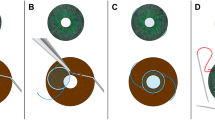Abstract
Background
Combined post-traumatic aniridia and aphakia demand extensive and complex reconstructive surgery. We present our approach for simultaneous correction of this surgical situation with the use of the ArtificialIris (Dr. Schmidt Intraocularlinsen GmbH, Germany) with a foldable acrylic IOL Lentis L-313 (Oculentis, GmbH, Germany) sutured to its surface. The novelty (our first operation was on June 2010) of this surgical technique is based on the combined use of foldable (with closed haptics) IOL and Artificialiris to correct post-traumatic aniridia and aphakia.
Methods
Four consecutive cases of combined post-traumatic lesions of iris and lens, corrected with complex device ArtificialIris and foldable IOL. In two cases, the compound implant was sutured to the sclera in sulcus during the penetrating keratoplasty; in another case, it was positioned through a corneal incision of about 5.0 mm with transscleral fixation, and in one patient with preserved capsular support and possibility of IOL in-the-bag implantation the ArtificialIris was placed in sulcus sutureless through a clear corneal tunnel.
Results
Maximal follow-up was 6 months. The complex device was placed firmly fixed within the sulcus, including in the eye implanted without sutures, and showed a stable and centered position without any tilt or torque.
Conclusion
Management of post-traumatic aniridia combined with aphakia by haptic fixation of a foldable acrylic IOL on a foldable iris prosthesis appears to be a promising approach which gives the surgeon the possibility to correct a complex lesion with one procedure, which is less traumatic and faster. Existence of foldable materials, both iris and IOL, permits relatively small corneal incisions (4.0–5.0 mm). Moreover, the custom-tailored iris prosthesis gives a perfect aesthetic result.






























Similar content being viewed by others
References
Viestenz A, Kuchle M (2002) Ocular contusion caused by elastic cords: a retrospective analysis using the Erlangen Ocular Contusion Registry. Clin Exp Ophthalmol 30(4):266–269
Cavallini GM, Lugli N, Campi L, Pagliani L, Saccarola P (2003) Bottle-cork injury to the eye: a review of 13 cases. Eur J Ophthalmol 13(3):287–291
Burk SE, Da Mata AP, Snyder ME, Cionni RJ, Cohen JS, Osher RH (2001) Prosthetic iris implantation for congenital, traumatic, or functional iris deficiencies. J Cataract Refract Surg 27(11):1732–1740
Hanumanthu S, Webb LA (2003) Management of traumatic aniridia and aphakia with an iris reconstruction implant. J Cataract Refract Surg 29(6):1236–1238
Olson MD, Masket S, Miller KM (2008) Interim results of a compassionate-use clinical trial of Morcher iris diaphragm implantation: Report 1. J Cataract Refract Surg 34(10):1674–1680
Brown MJ, Hardten DR, Knish K (2005) Use of the artificial iris implant in patients with aniridia. Optometry 76(3):157–164
Osher RH, Burk SE (1999) Cataract surgery combined with implantation of an artificial iris. J Cataract Refract Surg 25(11):1540–1547
Price MO, Price FW Jr, Chang DF, Kelley K, Olson MD, Miller KM (2004) Ophtec iris reconstruction lens: United States clinical trial phase I. Ophthalmology 111(10):1847–1852
Miller AR, Olson MD, Miller KM (2007) Functional and cosmetic outcomes of combined penetrating keratoplasty and iris reconstruction lens implantation in eyes with a history of trauma. J Cataract Refract Surg 33(5):808–814
Rosenthal KJ (2004) Prosthesis/IOL implantation. Cataract & Refractive Surgery Today I:78–80
Aslam SA, Wong SC, Ficker LA, MacLaren RE (2008) Implantation of the black diaphragm intraocular lens in congenital and traumatic aniridia. Ophthalmology 115(10):1705–1712
Reinhard T, Engelhardt S, Sundmacher R (2000) Black diaphragm aniridia intraocular lens for congenital aniridia: long-term follow-up. J Cataract Refract Surg 26(3):375–381
Sminia ML, Odenthal MT, Gortzak-Moorstein N, Wenniger-Prick LJ, Völker-Dieben HJ (2008) Implantation of the Artisan® iris reconstruction intraocular lens in 5 children with aphakia and partial aniridia caused by perforating ocular trauma. J AAPOS 12(3):268–272
Ayliffe W, Groth S, Sponsel WE (2012) Small-incision insertion of artificial iris prostheses. J Cataract Refract Surg 38(2):362–367
Spitzer MS, Yoeruek E, Leitritz MA, Szurman P, Bartz-Schmidt KU (2011) A new technique for treating post-traumatic aniridia with aphakia: haptic fixation of a foldable intraocular lens on a foldable and custom tailored iris prosthesis. Deutsche Ophthalmologische Gesellschaft.; abstr. № 476
Spitzer MS, Yoeruek E, Leitritz MA, Szurman P, Bartz-Schmidt KU (2012) A new technique for treating post-traumatic aniridia with aphakia. Arch Ophthalmol 130(6):771–775
Author information
Authors and Affiliations
Corresponding author
Additional information
The authors have no financial interest or relationship with any organization that produces any device used in this study.
The authors have full control of all primary data, and agree to allow Graefe's Archive for Clinical and Experimental Ophthalmology to review all the data upon request.
Rights and permissions
About this article
Cite this article
Forlini, C., Forlini, M., Rejdak, R. et al. Simultaneous correction of post-traumatic aphakia and aniridia with the use of artificial iris and IOL implantation. Graefes Arch Clin Exp Ophthalmol 251, 667–675 (2013). https://doi.org/10.1007/s00417-012-2254-7
Received:
Revised:
Accepted:
Published:
Issue Date:
DOI: https://doi.org/10.1007/s00417-012-2254-7




